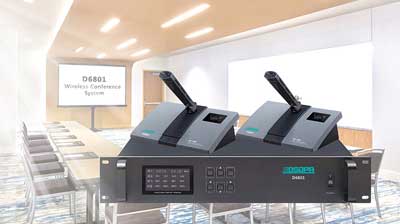

Leave a message



In the technological development of the conference system, it has unknowingly experienced three generations of full analog technology, analog audio transmission + digital control technology, and full digital technology (digital audio transmission + digital control technology), and the third generation conference system, full digital conference system, has the characteristics of excellent sound quality, powerful functions, and high reliability. It is the mainstream product in the current conference system market.
In recent years, computer technology, network technology, wireless transmission technology, etc. have developed rapidly. The application of these advanced technologies to the conference system will make the conference system more powerful, superior in performance, and more user-friendly.
Nowadays, wireless, networked, and paperless conference have become the main development directions of the conference system. Among them, the paperless multimedia conference system is expected to become the representative product of the fourth-generation conference system.

The wireless conference system has the advantages of no wiring, adaptable to real-time changes in the layout of the venue, no need to destroy the original decoration of the venue, convenient system maintenance, no need to worry about wire aging, easy storage, etc., so it is very popular in some high-end conference venues and large conference centers, favored by the administrative center.
Wireless conference systems mainly include radio frequency wireless conference systems and infrared wireless conference systems.

In the conference system, networking is mainly reflected in the following aspects: In a large conference center with multiple conference halls, the interaction and sharing of information and equipment can be realized, which reduces the investment in system construction and greatly improves management efficiency.
The conference system is interconnected with various servers (such as file servers, video servers) to realize file, multimedia information and external resource sharing (this is used in paperless multimedia conference systems); conference affairs disclosure, webcasting, etc.

"Paperless meetings" was proposed by the UN NGO Committee, which uses an all-electronic mode to operate meeting management to reduce paper consumption and improve meeting efficiency.
On January 1, 2010, the United Nations fully implemented "paperless" in the use and management of conference documents. At the same time, modern high-level conferences are no longer just voice-based audio conferences, but require a large amount of multimedia information interaction, such as conference materials, computer files, various video information, and web browsing.
In general, the paperless conference system introduces paperless conferences, video services, and conference services into the conference system, pushing the conference system technology to a new stage.
 【DSPPA Demo】PAVA8000 EN54 Voice Evacuation SystemNovember 12, 2020Abstract: DSPPA PAVA8000 EN54 Voice Evacuation SystemToday, we are gonna show you a demo about our PAVA8000 EN54 Voice Evacuation System.PAVA8000EN54 Voice Evacuation System can not only support manua...view
【DSPPA Demo】PAVA8000 EN54 Voice Evacuation SystemNovember 12, 2020Abstract: DSPPA PAVA8000 EN54 Voice Evacuation SystemToday, we are gonna show you a demo about our PAVA8000 EN54 Voice Evacuation System.PAVA8000EN54 Voice Evacuation System can not only support manua...view The National Standard Approval Meeting held in BeijingJuly 19, 2019The National Standard Approval Meeting held in BeijingThe approval meeting of the National StandardTechnical standard of public address system engineeringis held in Beijing on July 16, 2019. Xue Chang...view
The National Standard Approval Meeting held in BeijingJuly 19, 2019The National Standard Approval Meeting held in BeijingThe approval meeting of the National StandardTechnical standard of public address system engineeringis held in Beijing on July 16, 2019. Xue Chang...view


